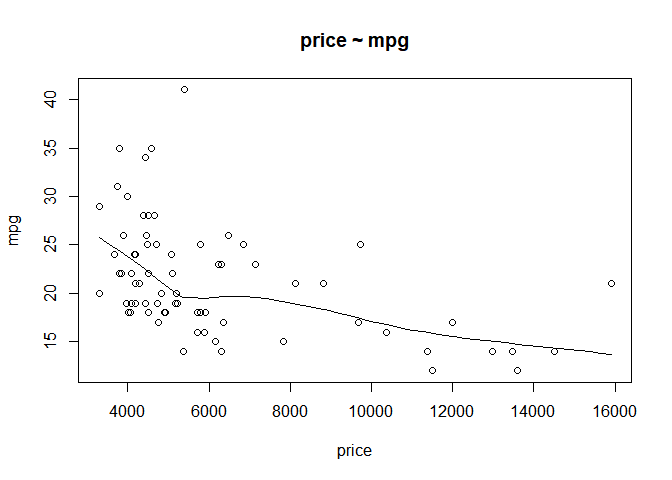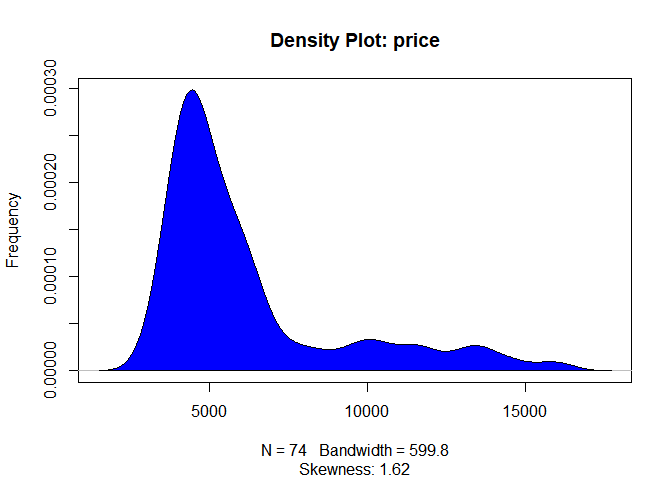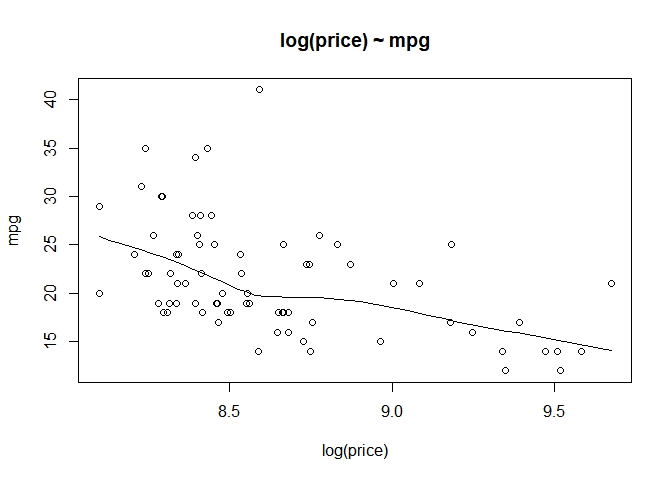
Today we will use R to establish a linear relationship between the price of a car and mpg(mileage).
Know about data
First of all, we import the auto.dta and view the first six observations for checking.
library(haven)
auto <- read_dta("auto.dta")
head(auto)
## # A tibble: 6 x 12
## make price mpg rep78 headroom trunk weight length turn displacement
## <chr> <dbl> <dbl> <dbl> <dbl> <dbl> <dbl> <dbl> <dbl> <dbl>
## 1 AMC ~ 4099 22 3 2.5 11 2930 186 40 121
## 2 AMC ~ 4749 17 3 3 11 3350 173 40 258
## 3 AMC ~ 3799 22 NA 3 12 2640 168 35 121
## 4 Buic~ 4816 20 3 4.5 16 3250 196 40 196
## 5 Buic~ 7827 15 4 4 20 4080 222 43 350
## 6 Buic~ 5788 18 3 4 21 3670 218 43 231
## # ... with 2 more variables: gear_ratio <dbl>, foreign <dbl+lbl>
Relationship Between Price and Mpg
We caculate the correlation between price and mpg. Futhermore, we can draw a scatter plot to sketch their relationship.
cor(auto$price, auto$mpg)
## [1] -0.4685967
scatter.smooth(x=auto$price, y=auto$mpg, main="price ~ mpg",xlab="price",
ylab="mpg")

Draw a density plot to scan the distribution of price.
library(e1071)
plot(density(auto$price), main="Density Plot: price", ylab="Frequency", sub=paste("Skewness:", round(e1071::skewness(auto$price), 2)))
polygon(density(auto$price), col="blue")

Linear Regression
Now we find that price and mpg have negative relationship, when mpg increases, price decreases. In order to know it deeply, we use linear regression to analyze.
linearMod <- lm(price ~ mpg, data=auto)
summary(linearMod)
##
## Call:
## lm(formula = price ~ mpg, data = auto)
##
## Residuals:
## Min 1Q Median 3Q Max
## -3184.2 -1886.9 -959.8 1359.7 9669.7
##
## Coefficients:
## Estimate Std. Error t value Pr(>|t|)
## (Intercept) 11253.06 1170.81 9.611 1.53e-14 ***
## mpg -238.89 53.08 -4.501 2.55e-05 ***
## ---
## Signif. codes: 0 '***' 0.001 '**' 0.01 '*' 0.05 '.' 0.1 ' ' 1
##
## Residual standard error: 2624 on 72 degrees of freedom
## Multiple R-squared: 0.2196, Adjusted R-squared: 0.2087
## F-statistic: 20.26 on 1 and 72 DF, p-value: 2.546e-05
We use log(price) to replace price and do the previous process again.
auto$lp<-log(auto$price)
scatter.smooth(x=auto$lp, y=auto$mpg, main="log(price) ~ mpg",
xlab="log(price)", ylab="mpg")

linearMod <- lm(lp ~ mpg, data=auto)
summary(linearMod)
##
## Call:
## lm(formula = lp ~ mpg, data = auto)
##
## Residuals:
## Min 1Q Median 3Q Max
## -0.58486 -0.25525 -0.08595 0.22935 1.02393
##
## Coefficients:
## Estimate Std. Error t value Pr(>|t|)
## (Intercept) 9.349342 0.153489 60.912 < 2e-16 ***
## mpg -0.033277 0.006958 -4.782 8.93e-06 ***
## ---
## Signif. codes: 0 '***' 0.001 '**' 0.01 '*' 0.05 '.' 0.1 ' ' 1
##
## Residual standard error: 0.344 on 72 degrees of freedom
## Multiple R-squared: 0.2411, Adjusted R-squared: 0.2305
## F-statistic: 22.87 on 1 and 72 DF, p-value: 8.93e-06
Conclusion
As seen in the results above, we can find that the p-values and t Statistic are statisticaly significant. But simple linear regression isn’t enough for idenifying casual effect, we will discuss it next time.
Reference
- r-statistics.co by Selva Prabhakaran




近期评论